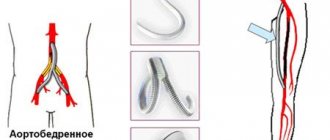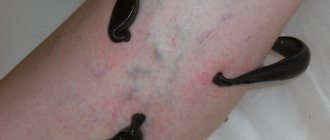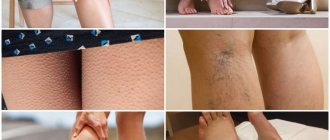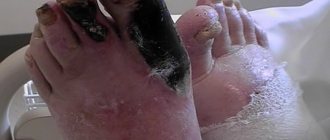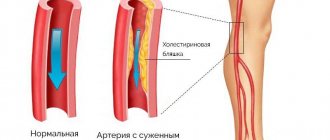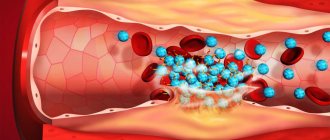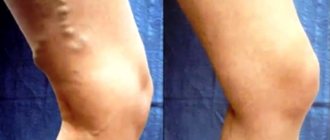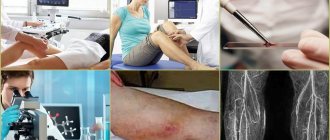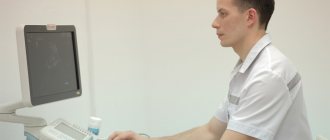What is thrombophlebitis, how does it manifest and why is it dangerous?
Thrombophlebitis is an inflammation of the walls of the deep veins of the lower extremities. Inflammation leads to the formation of clots and thrombi in the bloodstream, which can block the lumen of blood vessels and lead to poor circulation. Phlebologists distinguish two forms of the disease - acute and chronic.
The first symptoms of the disease:
- Strong feeling of fatigue in the lower extremities. Fatigue accumulates in the evening and is not related to the level of physical activity.
- Painful sensations, burning sensation in the legs.
- Body temperature 37-38°C. When taking antipyretics, the temperature drops for only a few hours, then rises again. The patient notes a deterioration in general health and weakness.
- Visible deformation of the vascular wall, bulging of blood vessels from under the skin, pain when touched.
- Redness of the skin in the area of vascular damage, increased local temperature.
- Stagnation of lymph, swelling of the lower extremities, enlarged lymph nodes in the groin area.
difference between superficial and deep vein thrombophlebitis
As the pathology progresses, the infection spreads to larger vessels, and a large number of blood clots form. Often the inflammatory process affects not only blood vessels, but also subcutaneous fatty tissue and skin.
Without treatment, thrombophlebitis leads to an increase in blood viscosity and deterioration of blood circulation, and greatly increases the invasiveness of the veins - these factors lead to the development of dangerous complications.
Complications of thrombophlebitis:
- bleeding;
- elephantiasis of the lower extremities;
- ischemic neuritis;
- sepsis;
- lymphangitis - inflammation in the lymphatic vessels;
- phlebosclerosis – thickening of the venous walls.
The most dangerous complication of thrombophlebitis is pulmonary embolism. The pathology is expressed in the blocking of the pulmonary artery by a thrombus, which most likely leads to the death of the patient.
The danger of pathology and general principles of therapy
Traditional methods of treating thrombophlebitis of the lower extremities are varied, but they are allowed to be used only in combination with the main therapy and after consultation with the attending physician. Lack of the desired effect or violation of the dosage can lead to the development of complications, including death.
On a note!
Pathology can occur in both acute and chronic forms. In acute cases, folk therapy will not relieve thrombosis of blood vessels in the legs.
Although folk remedies in the treatment of venous thrombophlebitis can have a positive effect, we must not forget about possible contraindications. Even natural products can provoke the development of adverse reactions or an attack of severe allergies.
Using folk remedies that thin the blood and prevent blood clots along with medications is not enough. It is important to change your lifestyle, diet and control moderate physical activity. You can discuss with your doctor what loads and exercises are permissible so as not to aggravate the course of the disease.
Treatment methods for thrombophlebitis
Treatment of thrombophlebitis with medications
For the treatment of thrombophlebitis and swelling of the lower extremities, tablets and preparations for external use are prescribed.
| Drugs for thrombophlebitis | |||
| Name | Release form | Action | Price |
| Dimexide | Ointment and gel for external use | Has an antibacterial and anti-inflammatory effect, provides local anesthesia | 150 rubles for a 30 g gel pack |
| Xarelto | Pills | Inhibits blood clotting factor, has an anticoagulant effect | A pack of 14 tablets costs from 1,500 rubles |
| Antiven | Solution for external use | Anti-inflammatory, analgesic, anesthetic effect | About 400 rubles for 100 ml of product |
| Diclofenac | Ointment, gel and cream for external use | Has anti-edematous, anti-inflammatory effect, relieves pain | From 30 rubles per package of product (40 g) |
| Detralex | Pills | Strengthens veins, reduces the distensibility of the venous wall, improves venous circulation | 700 rubles for 30 tablets |
| Troxerutin | Gel for external use | Relieves swelling, strengthens the vascular wall, relieves the feeling of heaviness in the legs | 40 rubles per pack of gel (40 g) |
The medications and duration of use are determined only by the doctor.
Reasons for appearance
Thrombophlebitis is characterized by the formation of a blood clot on the wall of a vessel as a result of inflammation. In most cases, it affects the lower extremities, developing from venous insufficiency and advanced varicose veins.
Thrombophlebitis is characterized by the formation of a blood clot on the wall of a vessel
The main factors provoking thrombophlebitis are:
- high blood clotting;
- damage to the venous walls as a result of inflammation, trauma, autoimmune effects;
- impaired blood circulation due to excess weight, pregnancy, lack of physical activity.
The main symptoms of thrombophlebitis of the legs:
- painful spasms when sitting for a long time;
- pain in the affected vein;
- swelling and aches;
- redness of the affected areas of the legs and an increase in their temperature;
Redness of the affected areas of the legs
- the appearance of painful nodes of a bluish tint;
- general feverish condition.
Before treating thrombophlebitis with traditional methods, it is recommended to visit a doctor, since significant damage to the veins can only be cured surgically in a hospital setting.
Treatment of deep vein thrombosis with folk remedies
Traditional methods will help improve the effect of drug treatment. It is impossible to use only traditional medicine recipes to treat deep vein thrombosis.
Apple vinegar
Natural apple cider vinegar is a natural anti-inflammatory. To treat the disease, you should rub the affected areas with undiluted apple cider vinegar 2 times a day until completely absorbed. The course of treatment is at least 1 month.
Using a honey compress
A honey compress will help quickly cure inflammation. Apply a small amount of honey to a piece of linen cloth, apply to the sore spot, secure with an elastic bandage, and leave overnight. To enhance the anti-inflammatory effect, honey can be mixed with a small amount of crushed Kalanchoe leaf. If inflammation is accompanied by pain, use a cabbage leaf instead of a cut of flax. The course of treatment is 2 weeks.
Elastic bandage
The elastic bandage exerts a compression effect on the lower extremities, prevents blood stagnation and the development of complications of thrombophlebitis.
You need to bandage your leg immediately after waking up, without getting out of bed. Before bandaging, the limb must be elevated by placing the heel on a bolster or pillow.
The leg must be wrapped starting from the foot, while the toes must remain free. In the lower part of the shin, the bandage should be applied most tightly, loosening the tension slightly as it is wound. Each subsequent layer must overlap the previous one by at least half the width of the product. It is recommended to finish wrapping 10-15 cm above the affected area.
Lower limb bandaging guide
Treatment with iodine
Iodine freely penetrates the body tissues through the skin, relieves inflammation, stimulates blood circulation, and increases local immunity. To treat thrombophlebitis, you need to make a mesh of 5% iodine solution on the affected areas 3-4 times a week.
Decoctions and infusions for thrombophlebitis
The best folk remedies for oral administration:
- Infusion of garlic and lemon. The product helps dissolve blood clots. To prepare the infusion, peel 4 lemons and 4 large heads of garlic, grind the ingredients in a blender and place the mixture in a three-liter jar. Fill the contents of the jar with cold boiled water up to the neck and close with a lid. Leave the product in a dark place for 5 days, then strain. Take 1/4 cup on an empty stomach. The course of treatment can last up to 1 year.
- Infusion of onion and honey. The medicine restores mobility to the lower limbs, relieves pain and swelling. Mix 200 ml of onion juice and 200 ml of liquid honey in a glass container, leave in a dark place at room temperature for 3 days, then store in the refrigerator for 10 days. Drink the infusion 1 tbsp. l. half an hour before meals 3 times a day. The course is 1-2 months, after 3 years the course can be repeated.
- Oak bark decoction. Oak bark strengthens the walls of blood vessels. In a metal pan, pour 1 tbsp. l. oak bark 200 ml of boiling water and boil for half an hour, then let it brew for another half hour. Strain the broth and drink 1 tbsp. l. 3 times a day before meals. Course – 4-6 weeks.
Symptoms of pathology
When superficial veins are involved in the process, the following symptoms appear:
- warmth, sensitivity and pain in the affected area;
- edema;
- a dense vein (hard cord) is palpated.
With inflammation of the deep veins, the following signs are observed:
- leg swelling;
- bursting pain;
- increase in body temperature.
The main substrate (cause) of thrombophlebitis, as mentioned above, is a blood clot. The appearance of blood clots may be preceded by certain changes in the body, namely those that lead to a slowdown in the movement of blood through the veins and damage to the vascular wall. This is most often observed in the following situations:
- insertion of a catheter or intravenous injection;
- inflammation of the vessel wall;
- prolonged bed rest;
- varicose veins;
- heart failure;
- wearing tight clothes and shoes;
- smoking and obesity;
- some genetic factors.
Herbs for varicose veins and thrombophlebitis
Herbal medicine recipes for strengthening blood vessels and relieving swelling in the lower extremities:
- Pine baths. Pour 200 g of pine needles into 1 liter of boiling water and boil for 20 minutes, then leave for 1 hour and filter. Take a bath with the decoction for 20 minutes at a water temperature of 30-35°C. The course of treatment consists of 15 procedures. Baths are effective for varicose veins of the lower extremities and at the initial stage of thrombophlebitis.
- Nettle infusion. Brew 1 tbsp. l. pharmacy nettle with 1 cup of boiling water and leave for 1 hour. Drink the infusion during the day in 3 doses. The course can be long.
- Tea made from hazel leaves. Brew 2 tbsp. l. dry hazel leaves with 2 cups of boiling water and let it brew for 15 minutes. Drink tea a day in 2-4 doses. The course is at least 1 month.
- Cumin seed tea. Brew 1 tbsp. l. black cumin seeds with 1 cup boiling water, leave to brew for 15 minutes. Drink 1/3 cup of cumin tea 3 times a day before meals.
Herbs have a tonic effect, improve the general condition of the body, and stimulate blood circulation.
How to relieve inflammation of the veins with thrombophlebitis?
The main manifestation of the disease is the inflammatory process in the vascular system of the body. Therefore, before treating thrombophlebitis of the lower extremities at home and dealing with cosmetic defects, it is important to relieve inflammation from the veins. This must be done in a hospital setting and under the supervision of a doctor.
Treatment will be aimed at eliminating inflammation of the veins, thinning the blood and removing blood clots. It consists of the following:
- providing the patient with bed rest;
- raising the limb affected by thrombophlebitis above the level of the body;
- increasing fluid intake per day;
- healthy, full sleep;
- prescription of anticoagulants that affect blood clotting and viscosity;
- the use of anti-inflammatory drugs, these can be tablets, creams, ointments, gels - depending on the stage of the disease;
- if the patient’s body temperature rises, then it is necessary to take medications that reduce it; it is not recommended to treat thrombophlebitis of the lower extremities at home during this period;
- in case of severe general condition, the doctor should prescribe antibiotics;
- if there is an improvement, then for 3-4 days you can use compresses and lotions on the sore leg;
- after intensive therapy, the patient should undergo a course of physiotherapy - magnet, infrared irradiation, galvanic procedures.
Treating thrombophlebitis at home is very dangerous; at any moment there is a risk that a blood clot will break off and block the vessel, creating a blood obstruction. If treatment is carried out under the supervision of a doctor, then the risks are minimized, and in case of an emergency, qualified specialists will always come to the rescue and make the right decision. At the same time, the home regime relaxes the patient, and movements are contraindicated for him. Any violation of prescriptions can lead to complications, and at home no one will control the patient except himself.
If treatment of inflammatory processes is impossible with the help of tablets and ointments, then the doctor prescribes injections. As a rule, these are drugs based on Diclofenac, which will not only eliminate inflammation in the veins and blood vessels, but also relieve pain.
Alternative medicine methods for thrombophlebitis include hirudotherapy, herbal infusions and acupuncture
Physical therapy complex, compression garments
Training for thrombophlebitis is designed to stimulate blood circulation in the lower body and prevent the development of complications. It is not recommended to sit or lie in the same position for a long time. Exercises must be performed every morning.
Set of exercises:
- Warm-up: swing your arms, bend forward and to the sides, circular movements with your hands and shoulders.
- Walk in place for 1 minute.
- Squats.
- Rolling from heel to toe and back.
- Swing your legs forward and backward.
- “Scissors” with legs from a lying position.
- Lifting the pelvis while lying on your back.
A set of exercises for varicose veins and thrombophlebitis.
The number of repetitions depends on the patient’s health condition; on average, 10-15 repetitions of each exercise are sufficient. The complex should be performed at a slow pace, breathing evenly and deeply. Jumping and weight-bearing exercises are prohibited.
For the treatment and prevention of thrombophlebitis, it is recommended to use compression stockings and tights. The degree of compression of the underwear and the size of the product are selected individually at a doctor’s appointment. Compression garments are put on in the morning in a lying position immediately after waking up, and removed before bedtime also in a lying position.
Risk factors
- Age over 60: Older people are more likely to have deep vein thrombosis. Those over 75 are at greatest risk, especially if they are overweight.
- Genetic factors: Some inherited traits can lead to genetic bleeding disorders or the production of too many platelets. This causes blood to clot too easily and increases the likelihood of a clot forming. The good news is that having thrombosis in your family does not necessarily mean you will get it yourself, as genetic predisposition usually must combine with other risk factors for a clot to form.
- Sedentary lifestyle: if you sit or lie all the time, lead an inactive lifestyle, do not walk or play sports, all this contributes to the development of stagnant processes in the body and the formation of blood clots. Frequent long flights, traveling in a car without the opportunity to get up and walk, sitting at a desk all day, watching television for many hours and immobilization after surgery, injury or other health conditions are also predisposing factors. Research shows that people who have recently suffered an injury or surgery that prevents them from walking and are therefore sedentary are at higher risk of developing blood clots.
- Heart attack or stroke. People who have had a heart attack, stroke, or heart disease are more likely to have clots than those who have not had heart disease. Those who have had injuries to their veins, during surgical procedures or other traumatic exposures, may also develop blood clots.
- Excess weight: While it's not entirely clear why being overweight or obese has been linked to a higher risk of blood clots, it may be because excess fat tissue increases estrogen levels. Estrogen stored in fatty tissue can contribute to clots, inflammation, and other problems that can cause deep vein thrombosis.
- Pregnancy: Women have a higher risk of developing blood clots during pregnancy and immediately after childbirth. Reasons for this include producing extra blood to support the fetus, increased pressure in the veins, changes in blood pressure and weight gain. The scary discovery is that pulmonary embolism (a clot going to the lungs) is one of the leading causes of maternal death during childbirth.
- Neoplastic diseases: Studies have shown that a history of certain types of cancer (especially lung, pancreatic, breast and ovarian cancer) may increase clotting.
- Smoking and drug use: All of the risk factors described above for deep vein thrombosis are worsened when you smoke cigarettes, use other tobacco products, or use drugs. Tobacco is even more dangerous when combined with medications that affect blood flow and hormone levels (such as estrogen).
- Menopause and hormonal changes: Some research suggests that changes in estrogen, including increased estrogen levels from birth control pills or hormone replacement therapy, can increase blood clotting and cause various heart complications. Menopausal women taking estrogen replacement medications are also at higher risk if they smoke, are overweight, and do not exercise.
Blood thinning
Alternative treatment for thrombophlebitis involves the use of blood thinners. In addition, you need to consume foods that help get rid of blood clots. These include lemon, garlic, nuts, and mushrooms. These products not only make the blood more fluid, but also help fight cholesterol deposits, which leads to improved elasticity of blood vessels.
To get rid of blood clots, you need to prepare a tincture of garlic and lemon. If you use this remedy for a month, it has a good effect on normalizing your health. Forest mushrooms, in particular, such as greenfinches, have healing properties. Eating them will help your blood not to thicken. Mushrooms can be stewed or boiled.
In case of deep vein thrombosis, the provoking factor must initially be eliminated. According to reviews, folk remedies for treating thrombophlebitis are most effective at the very beginning of the development of the disease. In addition, it is not recommended to neglect medications. Traditional methods are used only as aids.
Diet food
There is no need to follow a strict diet for the disease in question, but recommendations regarding the menu should be followed.
The diet includes foods that strengthen the walls of blood vessels and prevent blood clotting:
- fish;
- seafood;
- cereals and porridges;
- berries;
- vegetables;
- fruits;
- fermented milk products;
- nuts;
- dried fruits;
- vegetable oils.
Foods that can harm the veins and increase clotting should be avoided. In the diet it is necessary to limit:
- meat products;
- fried, smoked;
- pickled dishes;
- legumes;
- baking;
- coffee and cocoa;
- alcohol.
Despite the fact that the body needs adequate nutrition and vitamins, you should avoid phylloquinone. Vitamin K is involved in the process of blood clotting, so its excess can cause blood clots.
The following products contain the substance in large quantities:
- beef and pork liver;
- spinach;
- broccoli;
- kale;
- watercress.
Compliance with dietary nutrition is an integral part of the complex treatment of thrombophlebitis carried out at home.
Therapeutic baths
Treatment with folk remedies for varicose veins of the legs and thrombophlebitis is also carried out using special baths. They help cope with swelling, eliminate pain and normalize the patient’s well-being. The clot becomes much smaller and sometimes even dissolves.
A decoction of tannic root is widely used for baths. It needs to be boiled for 1 hour over low heat. You can also replace it with a decoction of willow or oak bark. Pour the finished medicinal product into a bucket so that most of the leg is covered with liquid. Wrap your legs in elastic socks to improve results. Do not overheat your feet, as this can cause complications.
Take 200 g of dried dried herb and brew it with boiling water in a bucket. Leave to brew well, having previously wrapped the bucket. When the liquid becomes warm, lower your feet into the bucket and hold for 30 minutes. It is recommended to do it daily before bed.
Effective treatment of thrombophlebitis with folk remedies can be carried out using a bath of oak and linden bark. To do this, take 100 g of bark and pour boiling water in a bucket. You need to steam your feet at night. After this, put stockings or a bandage on your legs.


